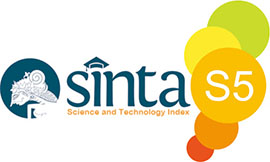PENGEMBANGAN MULTIMEDIA INTERAKTIF UNTUK MATA PELAJARAN GEOGRAFI KELAS VII PADA SEKOLAH MENENGAH PERTAMA
 ), Nofri Hendri(2), Diah Anggraini Austin(3),
), Nofri Hendri(2), Diah Anggraini Austin(3), (1) Universitas Negeri Padang
(2) Universitas Negeri Padang
(3) Universitas Andalas
 Corresponding Author
Corresponding Author
DOI : https://doi.org/10.24036/et.v11i1.124038
Full Text:
 Language : id
Language : id
Abstract
The development of multimedia learning is carried out as an effort to solve student learning problems, where students find it difficult to understand Social Sciences Geography learning material, so that it has an impact on student learning outcomes that are less than optimal. This study aims to produce valid, practical, and effective interactive multimedia products so that they are suitable for use in the learning process. This type of research is development research known as Research and Development (R&D). This study used the 4-D development model. Product validity was tested by 3 validators. Product trials were carried out on 25 class VII9 students of SMP N 18 Padang. In the effectiveness test there is a significant difference in the results of the pre-test and post-test conducted by students. As a result, it was found that the use of multimedia learning had an influence on the learning outcomes of class VII9 students in the Social Sciences Geography subject. Based on the results of the validity, practicality and effectiveness tests, it can be concluded that this interactive multimedia is suitable for use in the learning process.
References
Arifin, Zainal. 2012. Penelitian pendidikan. Bandung: PT Remaja Rosdakarya.
Arikunto, Suharsimi. 2012. Dasar-Dasar Evaluasi Pendidikan. Jakarta. Bumi
Aksara.
Beydoğan, H. Ö., & Hayran, Z. (2015). The Effect of Multimedia-Based Learning on the Concept Learning Levels and Attitudes of Students. Eurasian Journal of Educational Research, 60, 261-280
Bulut, R. (2018). Effects of social studies course designed in accordance with the multimedia learning principles on student motivation, achievement and attitudes. (Unpublished doctoral thesis). University of Afyon Kocatepe, Afyonkarahisar.
Çoruk, H. (2015). The effect of multimedia use on academic achievement and anxiety in elementary school students. (Unpublished master’s thesis). University of Amasya, Amasya.
Gülmez, E. (2019). Using YouTube as an educational technology for teaching concepts in pre-school. (Unpublished master’s thesis). University of Necmettin Erbakan, Konya.
Jones, M., & Liu, M. (1997). Introducing interactive multimedia to young children: A case study of how two-year-olds interact with the technology. Journal of Computing in Childhood Education, 8(4), 313-343.
Mayer, R. E. (1999). Multimedia aids to problem-solving transfer. International Journal of Educational Research, 31(7), 611-623
Nusir, S., Alsmadi, I., Al-Kabi, M., & Sharadgah, F. (2013). Studying the impact of using multimedia interactive programs on children's ability to learn basic math skills. E-Learning and Digital Media, 10(3), 305-319
Shilpa, S., & Sunita, M. (2013). A study about role of multimedia in early childhood education. International Journal of Humanities and Social Science Invention, 2(6), 80-85
Sugiyono. 2012. Metode Penelitian Kuantitatif, Kualitatif dan R&B. Bandung:
Alfabeta.
Trianto. 2012. Model Pembelajaran Terpadu : Konsep, Strategi, Dan Implementasinya Dalam Kurikulum Tingkat Satuan Pendidikan (KTSP).Jakarta PT bumi Akssara.
Warsita, Bambang. 2008. Teknolgi Pembelajaran. Jakarta: PT Rineka Cipta.
 Article Metrics
Article Metrics
 Abstract Views : 153 times
Abstract Views : 153 times
 PDF (Bahasa Indonesia) Downloaded : 50 times
PDF (Bahasa Indonesia) Downloaded : 50 times
Refbacks
- There are currently no refbacks.





